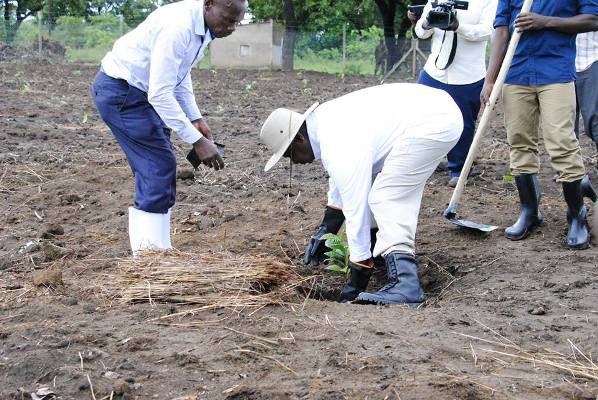Uganda produces about 5 million metric tons of maize annually
The National Agricultural Research Organization (NARO) has responded to Daily Monitor’s headline regarding Ugandan maize posing cancer risk. In a statement signed off by Dr. Ambrose Agona, the NARO Director General, NARO says: “The headline was misleading to the readers, without considering the impact it would have, particularly on consumers of maize, farmers and maize-based value-added products and the market within and outside the country.”
Below is NARO’s full statement:
Our attention is drawn to the Daily Monitor story that featured on Sunday, February 19, 2023, titled “Uganda’s maize poses a cancer risk“—experts.
This story has caused fear and alarm in the public about the quality and safety of maize on the market. The headline was misleading to the readers, without considering the impact it would have, particularly on consumers of maize, farmers and maize-based value-added products and the market within and outside the country.
Below are the facts regarding the Aflatoxin situation and management efforts in Uganda.
Status of grain handling in Uganda
The Ministry of Agriculture, Animal Industry, and Fisheries (MAAIF) has developed and is implementing policies on nutrition, food and safety, while the Ministry of Trade, Industry and Cooperatives has developed the grain standards and grain policies, all aimed at improving grain quality to meet national, regional and international standards for marketing with a focus on mitigating contamination of grain with aflatoxin and the associated health risks to consumers The grain traders under the East African Grain Council (EAGC) and the Grain Council of Uganda (TGCU) are vigorously promoting and implementing capacity building in grain handling standards for increased safety, quality and cross-border grain trade. The private sector has also significantly complemented Government efforts by increasing capacity in post-harvest handling and grain storage, aimed at minimizing contamination of grain by aflatoxin and any other mycotoxins meeting grain standards for trade.
To date, over 180 modern grain silos of different sizes have been installed in the country to facilitate safe storage of grain and consequently mitigate Mycotoxins/Aflatoxins contamination. Uganda produces about 5 million metric tons of maize annually thus, there is a gap in storage facilities that the Ministry is currently addressing.
Research efforts toward Aflatoxin control and management
Several technologies have been recommended to reduce crop aflatoxin content and subsequent human and animal aflatoxin exposure. These include cultural practices, biological control, host resistance, monitoring and crop destruction, grain drying, sorting, storage, post-harvest processing, and dietary interventions.
Biological control is also an efficient and cost-effective method to prevent contamination during pre- and post-harvest. At the heart of biocontrol technology to manage pre-harvest aflatoxin contamination of groundnut, sorghum, and maize are native and well-adapted atoxigenic (cannot produce aflatoxin) strains belonging to widely distributed genetic groups of the fungus Aspergillus flavus. When selected, the friendly fungi are applied to the soil prior to crop flowering, they reduce aflatoxin in the farm by “pushing out” their toxic cousins, reducing aflatoxin in crops through a process known as “competitive exclusion.”
The Government of Uganda, through NARO, has been and is funding research efforts towards aflatoxin control and management, and these efforts have led to a solution called Aflasafe. NARO has prioritized research on food and feed safety and has built capacity on aflatoxin research and testing for routine analysis of samples. Government also stepped-up awareness creation, for example, on October 31, 2018, the Ministry of Agriculture, Animal Industries and Fisheries launched an anti-mycotoxin campaign with special emphasis on aflatoxin mitigation, management and control.
What is Aflasafe? Aflasafe is an environmentally friendly, safe, and easy-to-use product that consistently reduces aflatoxin contamination by more than 80% mainly pre-harvest. The technology is currently registered in nine countries in Africa, including Tanzania and Kenya in East Africa, and is being developed in eight other countries.
In Uganda, we are currently validating the product in farmers’ fields to generate sufficient data for official registration and approval of the product for commercialization. This testing has been going on collaboratively between NARO and International Institute of Tropical Agriculture (IITA) since 2020, with promising results of more than 85% reduction in aflatoxin levels in maize, sorghum, and groundnut samples. Key drivers for the success of this technology will include (i) increased awareness about aflatoxin and its management, (ii) increased capacity and capability for routine aflatoxin testing, and (iii) incentivized premium prices for quality grain meeting trade and health standards.
As regards feed safety, NARO has developed and patented a “NARO aflatoxin binder”. The aflatoxin binder is composed of natural aluminosilicate clays obtained from the Albertine graben region of Uganda. Once incorporated into animal feeds contaminated with aflatoxin, the binder sequesters the toxins from the feed and binds with them to form an insoluble complex which is then passed out of the animal’s body as part of the fecal material. Consequently, the bound toxins are deprived on entering into the animals’ blood stream and getting assimilated into livestock tissues and products including eggs, milk and meat.
Fortification of aflatoxin-contaminated feeds with the NARO aflatoxin binder at a rate of 1% has scientifically been proven to boost feed intake, growth rate and immunity to key diseases notable Newcastle disease in poultry. Most importantly, the binder prevents aflatoxin carry-over into livestock products, hence alleviating exposure of consumers of livestock products to health risks.
The public is informed that there is no need for alarm. Uganda’s maize is safe, given the grain standards and grain policy frameworks in place to ensure the safety of grain in the market. NARO, together with partners, is and will continue providing solutions to everyday problems that affect agriculture in Uganda.





